The Network Security Policy Management Market is estimated to be valued at USD 2.3 billion in 2025 and is projected to reach USD 4.4 billion by 2035, registering a compound annual growth rate (CAGR) of 6.7% over the forecast period.
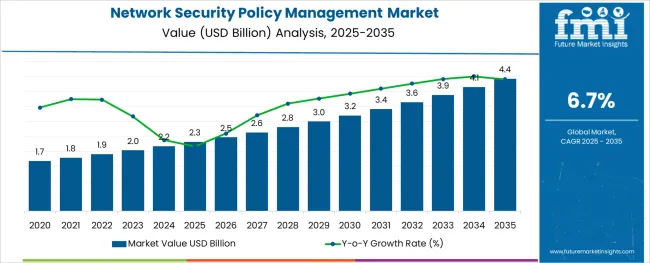
The network security policy management market is experiencing sustained momentum as enterprises globally prioritize the modernization of their IT infrastructure and security frameworks to combat escalating cybersecurity threats.
The growing complexity of enterprise networks, driven by cloud migration, hybrid work environments, and increased data traffic, has amplified the demand for centralized, automated policy management solutions.
Organizations are progressively investing in network security policy management tools to address compliance requirements, mitigate risks, and enhance operational efficiency through streamlined security policy enforcement. The market is poised for further growth as businesses across critical sectors recognize the necessity of integrating advanced, AI-driven solutions for real-time policy updates, incident response, and risk analytics.
Future expansion will be supported by increased adoption within small and medium-sized enterprises, alongside heightened emphasis on regulatory adherence in highly regulated industries such as finance, healthcare, and government services. Continuous product innovations focused on multi-cloud and hybrid IT environments, coupled with vendor emphasis on interoperability and automation capabilities, are expected to secure long-term demand for these solutions across diverse end-use industries.
The market is segmented by Component, Solution, End-use, and Enterprise Size and region. By Component, the market is divided into Software and Services. In terms of Solution, the market is classified into Security Policy Management, Change Management System, and Risk and Vulnerability Analysis. Based on End-use, the market is segmented into Banking, Financial Services, and Insurance (BFSI), Healthcare, Government, IT & Telecom, Retail, Transportation, Energy & Utilities, and Others.
By Enterprise Size, the market is divided into Small & Medium Enterprises (SMEs) and Large Enterprises. Regionally, the market is classified into North America, Latin America, Western Europe, Eastern Europe, Balkan & Baltic Countries, Russia & Belarus, Central Asia, East Asia, South Asia & Pacific, and the Middle East & Africa.
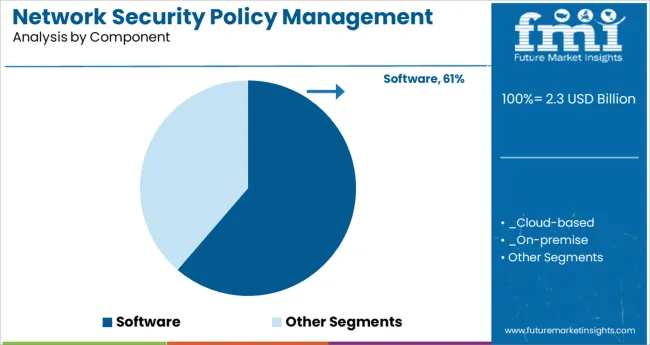
The software segment commanded a dominant 61.3% share of the network security policy management market, reflecting its critical role in enabling centralized control, automation, and optimization of security policies across increasingly complex network architectures. Organizations continue to favor software-based solutions for their scalability, compatibility with hybrid and multi-cloud infrastructures, and ability to seamlessly integrate with existing security ecosystems.
The segment’s growth is further underpinned by heightened awareness regarding cybersecurity risks, rising compliance obligations, and the need for real-time policy adjustments in dynamic enterprise environments. Enterprises are actively deploying software platforms equipped with advanced features such as policy simulation, vulnerability assessment, and automated rule management to enhance operational agility and minimize security gaps.
As cybersecurity strategies evolve to address sophisticated threats and diverse IT ecosystems, software-based network security policy management is expected to remain the backbone of enterprise security frameworks. The anticipated expansion of AI-driven and SaaS-based policy management offerings is likely to further solidify this segment’s leadership position in the years ahead.
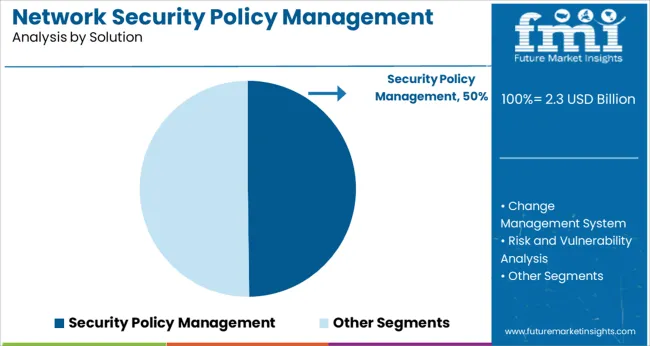
Within the component category, the security policy management segment accounted for approximately 49.8% of the market share, reinforcing its status as the leading solution category in the network security policy management space. This segment’s growth has been sustained by the increasing necessity for enterprises to efficiently manage complex security policies, ensure compliance, and protect critical infrastructure in real-time.
The surge in adoption of cloud services, coupled with the proliferation of remote work arrangements, has heightened network exposure to potential threats, compelling organizations to prioritize comprehensive policy management tools. These solutions enable centralized visibility, policy standardization, and automated enforcement across diverse IT assets and multi-cloud environments.
Vendors are continually enhancing their offerings with AI-powered analytics, policy conflict resolution, and dynamic rule optimization features to address evolving enterprise requirements. As regulatory frameworks and cyber risk landscapes grow more intricate, the security policy management segment is poised for consistent growth, with demand expected to remain strong among sectors with stringent data security mandates and high operational risk exposure.
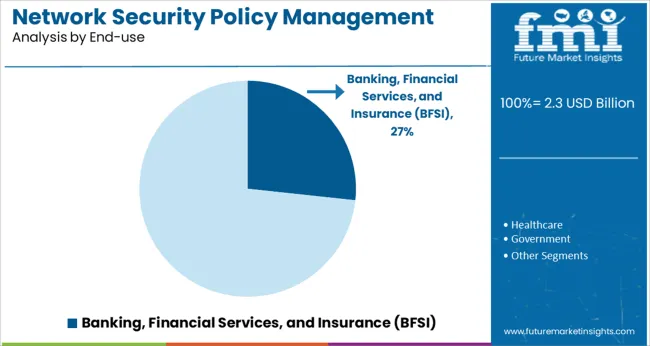
The banking, financial services, and insurance (BFSI) segment held a substantial 26.7% share of the network security policy management market, underscoring its position as a primary end-user industry for these solutions. The high adoption rate within BFSI is driven by the sector’s heightened exposure to cyber threats, stringent regulatory requirements, and the critical nature of financial data security.
Financial institutions increasingly rely on advanced policy management solutions to safeguard sensitive customer data, ensure continuous compliance with regional and international data protection laws, and maintain uninterrupted service availability. The growing shift toward digital banking services, mobile transactions, and cloud-hosted financial platforms has further escalated security risks, prompting firms to invest in sophisticated policy governance tools.
Vendors serving this segment are focusing on integrating AI-driven threat intelligence, automated policy orchestration, and regulatory reporting capabilities to support complex financial IT environments. The BFSI sector’s continued prioritization of cybersecurity investments, coupled with its reliance on complex, interconnected digital infrastructures, is expected to sustain the demand for network security policy management solutions over the forecast period.
Today, cyber threats affect more than just personal computers as they also affect office systems, encouraged by many workplaces in many regions which have a weak network layer.
Data breaches, cybercrime, and threats can all easily disrupt networks in the workplace. Furthermore, the network contains a massive amount of sensitive data. All of this contributes to increased cyber threat issues in businesses.
Hence, the adoption of network security policy management across the world is on the rise, thereby curbing several cyber-attacks.
Many businesses are increasing their investments in network security management, in turn fostering the network security policy management key trends & opportunities.
In many parts of the world, people are unaware of the cyber threat; as a result of which, many businesses fail to take cyber threats seriously, which, in turn, impedes the adoption of network security policy management services in those regions.
Another factor restraining the demand for network security policy management services is that most of the time, these cyber threats are discovered after significant damage has been done, which is considered vain.
Many places have a scarcity of network-security policy management solutions hampering the network security policy management market opportunities.
Most businesses do not invest in network security policies as some businesses believe it requires a large initial investment, and this notion is likely to negatively affect the network security policy management market statistics.
The high initial investment is a major stumbling block in the network security policy management market's future trends.
By component, the network security policy management market is segmented into software and services, where the Software segment is sub-segmented into Cloud-Based, On-Premise, and Services are sub-segmented into professional Services, and Managed Services.
By solution, the market is categorized into security policy management, change management system, risk and vulnerability analysis, and application connectivity management.
The market, on the basis of end-user, is segmented into Banking, Financial Services and Insurance (BFSI), healthcare, government, IT & telecom, retail, transportation, energy & utilities, and others.
By enterprise size, the security policy management market is categorized into Small & Medium Enterprises (SMEs), and large enterprises.
The services segment is anticipated to lead the network policy management market with a CAGR of 9.0% during the forecast period 2025 to 2035.
The service segment is likely to dominate the market during the forecast period as a result of its growing popularity and use, and this trend is expected to continue in the forecast period as networking and cross-communications among IT industries increase.
Banking, Financial Services, and Insurance (BFSI) is expected to dominate the market growing at a rate of 7.4% from 2025 to 2035.
The BFSI industry vertical is expected to have the largest network security policy management market share as it deals with large amounts of sensitive and private financial data and as the BFSI is the most targeted industry vertical.
Enterprises in the BFSI sector are requesting security policy management solutions to ensure irreversible security. Furthermore, the industry vertical is the most regulated, as it must meet numerous security requirements.
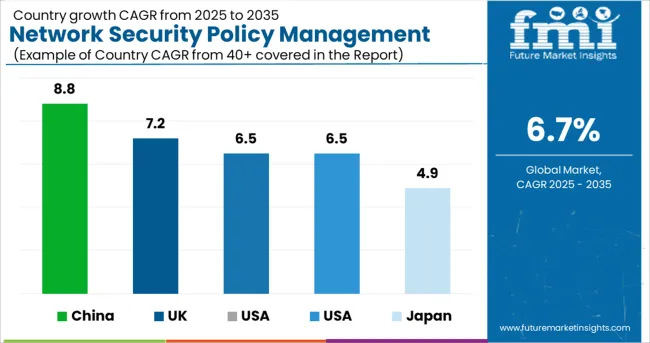
| Regions | CAGR (2025 to 2035) |
|---|---|
| USA Market | 6.5% |
| UK Market | 7.2% |
| China Market | 8.8% |
| Japan Market | 4.9% |
| India Market | 6.5% |
During the forecast period, the USA market is anticipated to experience high profitability rates with a CAGR of 6.5% from 2025 to 2035.
In these regions, there is also an exceptional network security policy management market with top leaders vying for a larger network security policy management market share.
The market's key players are likely to make numerous developments contributing to the region’s network security policy management market statistics.
Demand for network security policy management services in India and China is constantly increasing since cyber-attacks, data breaches, and the misuse of sensitive information are all on the rise.
As the Indian and Chinese regions have less secure online networks, the trajectory for network security policy management services adoption trends is likely to go up as they are much needed in those regions.
There is a great deal of concern about cyber-attacks. As a result, network security policy adoption is likely to be higher during the forecast period.
Emerging trends in the network security policy management market are growing trend in the UK. This is considered a significant contributor to the global network security policy management market growth.
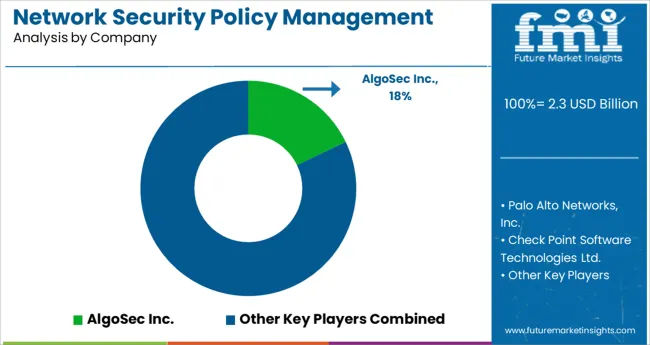
There is comparatively less competition in the network security policy management market.
However, network security policy management market growth is rapidly increasing as new businesses are expected to emerge during the forecast period.
There are also network security policy management market opportunities for large corporations to invest in the market.
The security policy management vendors are working to raise awareness about security solutions.
Product changes and technological advancements are examples of market developments.
During this time, the market's key players are forming new alliances and planning market expansion strategies in order to consolidate their market position by expanding their network security policy management market share.
Some of the recent developments in the network security policy management market are as follows:
Vital Market Players include:
The global network security policy management market is estimated to be valued at USD 2.3 billion in 2025.
It is projected to reach USD 4.4 billion by 2035.
The market is expected to grow at a 6.7% CAGR between 2025 and 2035.
The key product types are software, _cloud-based, _on-premise, services, _professional services and _managed services.
security policy management segment is expected to dominate with a 49.8% industry share in 2025.






Full Research Suite comprises of:
Market outlook & trends analysis
Interviews & case studies
Strategic recommendations
Vendor profiles & capabilities analysis
5-year forecasts
8 regions and 60+ country-level data splits
Market segment data splits
12 months of continuous data updates
DELIVERED AS:
PDF EXCEL ONLINE
Network Simulator Software Market Size and Share Forecast Outlook 2025 to 2035
Network Connectivity Tester Market Size and Share Forecast Outlook 2025 to 2035
Network Analyzers Market Size and Share Forecast Outlook 2025 to 2035
Network as a Service (NaaS) Market Size and Share Forecast Outlook 2025 to 2035
Network Analytics Market Size and Share Forecast Outlook 2025 to 2035
Network Devices Market Size and Share Forecast Outlook 2025 to 2035
Network Sandboxing Market Size and Share Forecast Outlook 2025 to 2035
Network Access Control (NAC) Market Size and Share Forecast Outlook 2025 to 2035
Network Monitoring Market Size and Share Forecast Outlook 2025 to 2035
Network Encryption Market Size and Share Forecast Outlook 2025 to 2035
Network Packet Broker Market Size and Share Forecast Outlook 2025 to 2035
Network Traffic Analytics Market Size and Share Forecast Outlook 2025 to 2035
Network Function Virtualization (NFV) Market Size and Share Forecast Outlook 2025 to 2035
Network Cable Tester Market Size and Share Forecast Outlook 2025 to 2035
Network Point-of-Care Glucose Testing Market Size and Share Forecast Outlook 2025 to 2035
Network Forensics Market Size and Share Forecast Outlook 2025 to 2035
Network Telemetry Market Size and Share Forecast Outlook 2025 to 2035
Network Probe Market Size and Share Forecast Outlook 2025 to 2035
Network Traffic Analysis Solutions Market Size and Share Forecast Outlook 2025 to 2035
Network Slicing Market Size and Share Forecast Outlook 2025 to 2035

Thank you!
You will receive an email from our Business Development Manager. Please be sure to check your SPAM/JUNK folder too.
Chat With
MaRIA